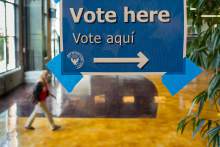This is an archived article that was published on sltrib.com in 2017, and information in the article may be outdated. It is provided only for personal research purposes and may not be reprinted.
"The voters should choose their representatives, not the other way around."
Utah is not guilty of some of the more extreme voter suppression tricks found in some states. It doesn't make it hard for minorities to register, impose absurd ID requirements or backpedal on recent moves to add more time and more places for people to vote.
It doesn't have to. Instead, members of the ever-dominant Republican Party employ one of the oldest election manipulation dodges there is. One that cooks the books to such a degree that a great many people aren't prevented from voting, they just don't see any reason to bother.
Now a new bipartisan group is putting together a voter initiative called "Better Boundaries." Its goal is to end the Utah Legislature's habit of drawing legislative and congressional districts so that the Republican Party never comes out of any election with less power than it had going in.
Combined with the caucus/convention system of nominating candidates, the atmosphere is such that Republicans dominate the political landscape and far-right activists dominate the Republicans. Thus is a natural center-right state drawn, on issues from guns to schools to public lands, to a far-right position that represents the views of a few true believers over those of the real majority of Utahns.
It's a technique known as gerrymandering, named for the 19th century governor of Massachusetts, Elbridge Gerry, who presided over a transparently biased redistricting of that state in ways that favored his party. At least one district was so stretched out and convoluted that it suggested the shape of a salamander, thus the Gerry-mander.
The U.S. Supreme Court has agreed to take a case arguing that the Wisconsin Legislature has taken such gerrymandering to an unconstitutional extreme. Depending on how that case goes, it could have a real impact on Utah.
But the Better Boundaries project leaders are not content to wait to, maybe, be rescued by the courts. They are taking advantage of the initiative provision of Utah law, to allow Utah voters to demand a change in the way Utah districts are apportioned.
The initiative, if it gets on the ballot and if it is approved by the voters, would take the colored pencils away from the Republican-controlled Legislature and give them to an independent commission that would be much more likely to draw districts in logical, compact ways.
Whether that commission's work would be the final word or subject to legislative approval, or tinkering, is still up in the air. Either way, it would be an improvement.
Such a change would not pull Utah from far right to far left. It might tweak it to the center, in part by making more legislative and congressional races competitive and encouraging both parties to run candidates and campaigns that would appeal to the widest swath of the electorate.
Even more important would be the likely result that the great mass of voters would feel as though their support was sought, their votes mattered, and they would not only be more likely to vote, but to run and to boost voter participation to levels that make our government truly representative of the people.



